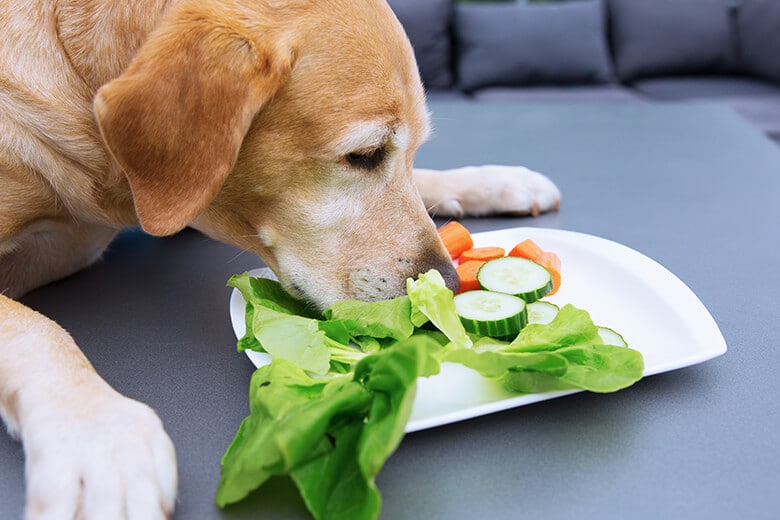Dogs love meat. That’s a fact, and not really up for debate.
But they’re not strictly carnivores like cats, who are classified as obligate carnivores, meaning they must eat meat to survive. Dogs are classified as scavenging, or facultative carnivores. They are primarily meat-eaters, but can survive on plants if needed.
Does that mean that dogs are really omnivore?
There has been a lot of debate about the carnivore/omnivore identity of dogs. Dr. Karen Becker, an “integrative wellness veterinarian,” has this to say: “Just because dogs fed plant-based diets are able to stay alive doesn’t make them omnivores.” Yet an all-meat diet is not necessarily healthy for dogs, either.
So, the answer is not simple. (Unless you asked a dog, who, I’m fairly certain, would ask for sausage.) In fact, if a vegetarian diet is created by a veterinarian nutritionist, a dog can survive on veggies alone. And for dogs that have allergies to meat or poultry, that’s an option.
But do we want our dogs to survive … or thrive?
Related: The Beginner’s Guide to Home Cooked Food for Your Dog
Dogs need meat to thrive, says T. J. Dunn, Jr., DVM. I tend to agree. So does Mary Straus, who runs a website called DogAware.com and writes for the WholeDog Journal, a holistic dog newsletter.
“If you aren’t willing to give a dog the diet it really wants, get a rabbit or a guinea pig,” she told the The New York Times. “There are lots of herbivores out there that make great pets.’”
In other words, although dogs can digest certain plant-based food and grains, they have certain protein requirements that are best served by meat.
A dog’s anatomy can tell us a lot about why meat is important to include in their diet.
Here are some indicators:
The Mouth
Most mammals produce amylase in the saliva, which is an enzyme that converts starch into simple sugar. That’s why chewing food helps start the digestive process in carbohydrates. Dogs do not have amylase in their saliva, which may be why they don’t chew their food for very long.
The teeth and the jaw structure of a dog is meant for eating meat. The pointy canine teeth are designed to tear meat apart. The strength of the jaw bone is made for chomping on bone and cartilage.
Related: Are You Storing Your Dog’s Food the Right Way? If Not, It Could Put Your Pup in Danger.
Jaw Movement
Human can move their jaws both up and down and side to side. Dogs can only move their jaw up and down. There’s a reason for that. Viva Health explains: “Most carnivores are predators who hunt, kill and butcher their prey. These predators kill either with a single, strong penetrating bite or several more shallow bites.” Additionally, “Omnivore dentition is not well adapted to process tough and fibrous plant matter. Hence, their food is either swallowed in whole chunks or simply crushed, but not thoroughly ground and chewed.”
Digestive Tract
Dogs have a much shorter digestive tract than we do. What this means is that dogs have trouble digesting, eliminating and processing a plant-based diet in the stomach or the liver. And while dogs do produce amylase in their pancreas and small intestine, it’s far down in their digestive track. That’s why some vegetables go in and come out in the same form. The dog body cannot digest them.
A dog’s digestive tract is more acidic than humans — from 10 to 100 times more acidic than human stomachs. This is because dogs eat meat and bones, which acid helps to digest. Also, since dogs and wolves in the wild would eat the internal organs of an animal first, a short digestive tract helps digest these parts quickly. Since the meat may contain toxins that are harmful, a short digestive tract moves the food through the dog’s body quickly, elimintaing those toxins.
Nutrition
Humans usually need to be watchful of the cholesterol numbers and food that raises LDL, or harmful cholesterol. Dogs don’t have the same concern. Their intestinal tract is able to handle much larger quantities of fat.
Tuffs Hospital notes, “Unlike humans, dogs naturally have very little of the ‘bad’ cholesterol in their blood and almost all ‘good’ cholesterol, so they have an advantage from the start to have a lower risk for atherosclerosis than we do.” In other words, dogs can eat much more meat, especially red meat; all they need to do to control cholesterol is get enough exercise.
As a vegetarian myself, I have struggled with feeding my dogs meat, with handling and cooking it. What I can do is try to buy meat from sources that are certified humane. But I want to keep my dogs as healthy (and happy) as I can, so I do feed the meat.
DogFoodAdvisor puts it succinctly, “Whether you believe they’re carnivores or omnivores, dogs possess an undeniable carnivorous bias.”



















